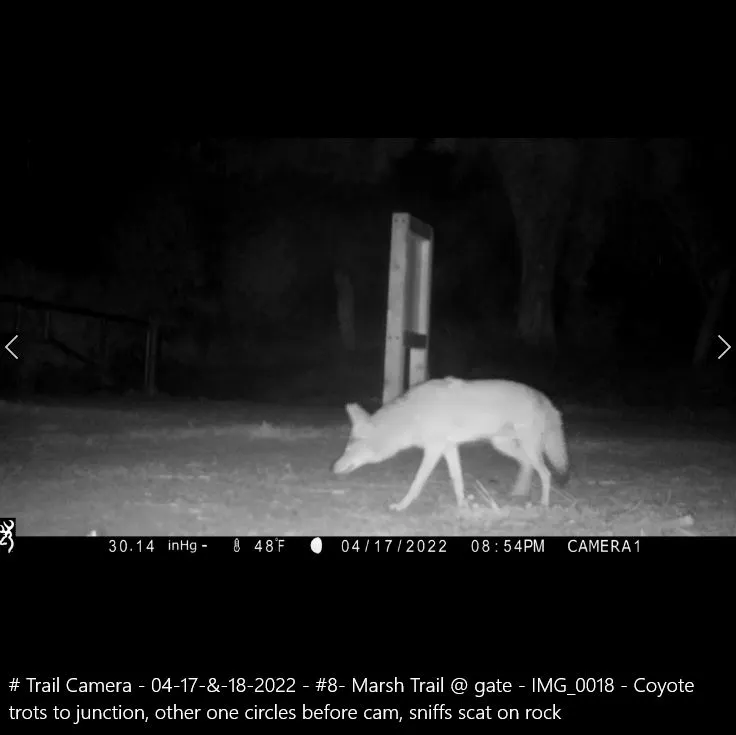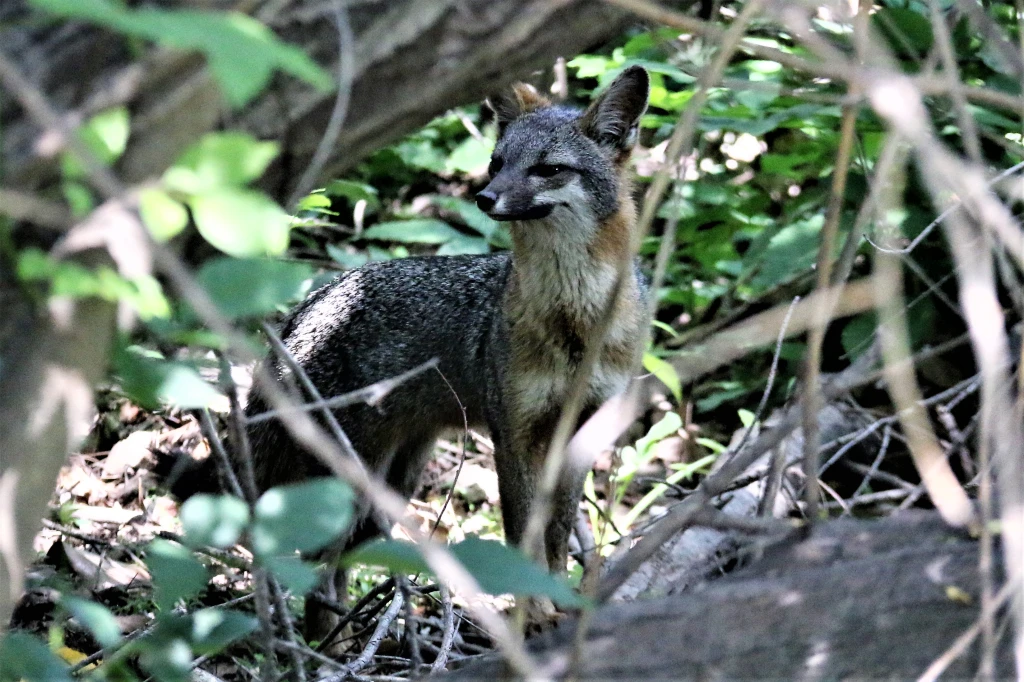Beavers, Coyotes and Gray Foxes
by William C. Leikam
President, CEO & Co-founder, Urban Wildlife Research Project
An email popped into my inbox. In part, it read, “… It was quite large, maybe ~40 lbs., heavy. Unfortunately, I didn’t see its tail. …, but given how big it was I’m leaning towards a beaver. … I was coming down from the opposite side of the channel, down the concrete “road” beside the municipal facility.” (Quote used with permission.)
“Got it.” On March 22, 2022, I installed a trail camera at the location where it was seen. If it was a beaver, it will likely return to that same spot. On Wednesday, March 30, 2022, the beaver emerged from the creek but the camera caught only the left half of it as it groomed itself. Log entry From the Files, Beaver @ camera #12, @ 12:25AM, 12:27AM, 5:20AM, 5:21AM. Since that first sighting, it has been documented on numerous occasions as the beaver comes from the water to groom and eat willow.

This is an historic first for Matadero Creek for in doing a search, no one has ever documented beaver along that creek. However, about two years ago, one was spotted, but not physically documented, over on Adobe Creek. From the two descriptions, it appears as if the beaver in Matadero Creek may be the same one that had been on Adobe Creek.
Beaver expert Dr. Heidi Perryman said that these beavers were using the Bay to move into new territory. She indicated that this was likely to be a young male in search of a mate and fresh territory.

We shall see how this plays out.
Beavers are rather benign in contrast to coyotes; ‘yotes’ as some folks call them. Within the Palo Alto Baylands Nature Preserve, there have been the occasional appearance of a coyote; usually just a single coyote looking for a mate and territory. In checking through my files as I processed them, at first there was but a single young coyote passing before camera #8 down on the road in Fox Hollow.
On Friday, April 1, 2022, two young coyotes passed by the trail camera. They trotted off toward the junction over by Jose’s office complex. From that night on until the end of April, those two coyotes came down the road from off in the direction of the truck washing pad. Sometimes they remained in the area for five to six minutes. During that time, it appears as if they are hunting cottontail rabbits nearby, while at other times they simply pass through.
Coyotes become a problem for gray foxes in that they prey on them and their pups. As adult, however, Laimos and Big Eyes, our pair of resident gray foxes, have a significant advantage over the coyote; namely that Laimos and Big Eyes climb trees and coyotes don’t. Let’s hope that this pair of young coyotes decides not to take up residency in the baylands, as that might “overload” the ecosystem with another keystone predator.
Gray Foxes General Health
These two foxes appear to be in good health. The previous indication that one of them may have worms has not proven to be the case.
Total Numbers of Gray Foxes in the Palo Alto Baylands Nature Preserve
As of this date, we have two adult gray foxes living in the Palo Alto Baylands Nature Preserve.
Section II
Update for the Urban Wildlife Research Project
Bill’s new book The Road to Fox Hollow has been released and can be found at Barnes & Noble Booksellers https://www.barnesandnoble.com/w/the-road-to-fox-hollow-wc-leikam/1140931306?ean=9781955690072 and directly from the publisher Di Angelo Publications at https://www.diangelopublications.com/books/the-road-to-fox-hollow. Dr. Marc Bekoff has an interview with Bill and that can be accessed at The Social and Emotional Lives of Urban Gray Foxes .
Bay Nature Magazine – How to be a Fox, the article about Bill and his ethological approach to his study of the gray fox is online here: https://baynature.org/article/how-to-be-a-fox/ Many are calling this a major article in the wildlife press.
BE SURE TO check out our YouTube Channel for some incredible wildlife videos at https://www.youtube.com/channel/UC5ujc7p8dU1-O5AbPAWz2_Q and our Facebook page.
LIVE & ONLINE Bill is schedule to make an online presesntation for the Point Reyes Birding & Nature Festival. Register now as the registration closes on April 15th. https://www.pointreyesbirdingfestival.org/
Bill has an additional live event coming up also in April 23rd at Safari West and on May 7th he will be live at Safari West https://www.safariwest.com/ in the Elephant Room.
Undoubtedly the best Radio interview ever – KALW (PBS program Crosscurrents) – by Sofie Kodner during December 2020 – Broadcast 1/11/2021 5:00 PM. Check it out here https://www.kalw.org/post/bay-area-wildlife-habitats-are-disappearing-fox-guy-has-plan
You can access Bill’s PowerPoint presentation Corridors & Connections: Sustaining the Health of All Wildlife presented during the October 24th P-22 Urban Wildlife Festival here: https://www.youtube.com/watch?v=Dh4MQL1D1Cc
NEW – To find out more about us, search Urban Wildlife Research Project, UWRP, gray foxes, wildlife connection, linkages, corridors and several documentaries including the video clips.
Section III
Gray Fox, Baylands Goals
Within the permit that allows the Urban Wildlife Research Project to conduct its study of the behavior of the gray fox at the Palo Alto Baylands Nature Preserve, the objectives covered area:
- Monitoring of urban gray fox Denning sites in Palo Alto Baylands.
This is being accomplished during the period when the gray foxes use a den site. It is one of the prime locations for gathering most of the behavioral data of the litter and for adults alike.
- Assessment of status and population trends of Baylands urban gray foxes
Since January 2019 a pair of resident gray foxes have claimed territory at the Palo Alto Baylands Nature Preserve.
- Identification of habitat features that promote the presence of urban gray foxes
After considering this and talking with people who know how to restore habitats, we need to assess what kinds of plants, including the Alkaline Salt Bush, would grow best along the edge of the saltwater channel and alongside the marsh. We need to grow a permanent habitat that contains the corridors and plant it as soon as possible. We’ll keep an eye on this as this is a critical link between the southern region of the Baylands and the northern region.
- Assessment of reproductive success and identification of factors that promote successful reproduction
Open up the pinch-point along Matadero Creek by developing thickets that link one area to another, instead of the present “islands”.
- Identification and assessment of possible dispersal travel routes.
Presently there can only be guesses as to dispersal travel routes. We intend to make this important question much more concrete when we attain our collaring/take/capture permit from the Department of Fish & Wildlife.




